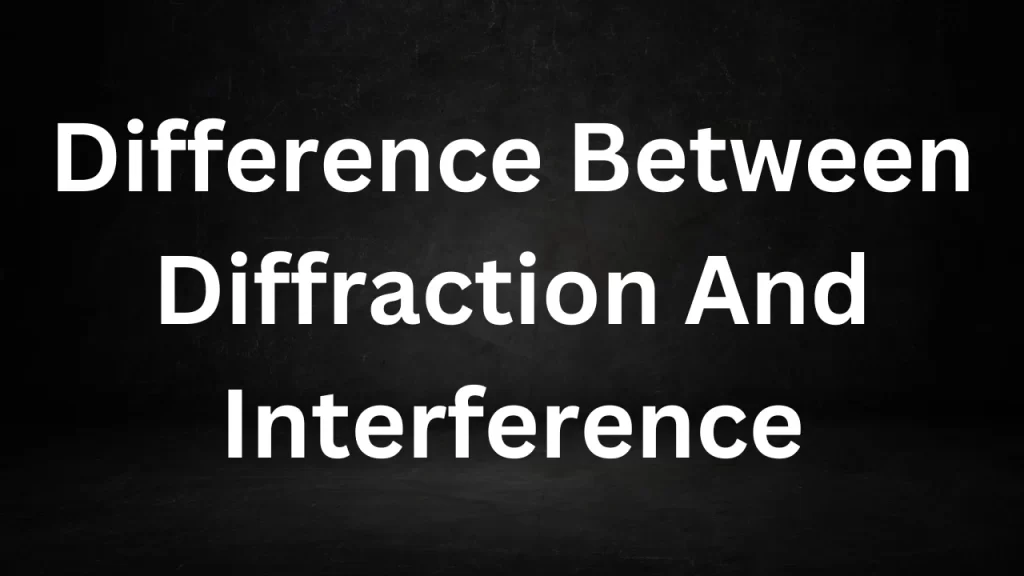Tag: constructive and destructive interference in x ray diffraction
Difference Between Diffraction And Interference
Difference Between Diffraction And Interference: Diffraction and interference are both wave phenomena that occur when waves interact with obstacles or slits, but they involve distinct mechanisms and produce different effects. Here’s a comparison of the key differences between diffraction and interference:

Difference Between Diffraction And Interference
1. Definition:
- Diffraction: Diffraction is the bending or spreading of waves as they encounter an obstacle or aperture (like a slit). It occurs when waves encounter an obstacle or aperture that is comparable in size to their wavelength.
- Interference: Interference is the interaction of two or more coherent waves (waves with the same frequency and phase) that results in the combination of their amplitudes. It occurs when two or more waves overlap in space and time.
2. Cause:
- Diffraction: Diffraction is caused by the bending of waves around obstacles or through apertures, leading to the wavefronts spreading out after passing through.
- Interference: Interference is caused by the superposition of waves from different sources or the splitting of a wave into multiple waves that then overlap and interfere constructively or destructively.
3. Wave Interaction:
- Diffraction: Diffraction occurs with a single wavefront encountering an obstacle or aperture. It involves the bending or spreading of that single wavefront.
- Interference: Interference involves the combination of multiple waves, often from different sources, that overlap in space and time, creating regions of constructive and destructive interference.
4. Resultant Pattern:
- Diffraction: Diffraction produces a pattern of waves that spread out in various directions after passing through an obstacle or aperture. The resulting pattern may exhibit a central maximum and secondary maxima and minima.
- Interference: Interference produces an interference pattern characterized by alternating regions of high (constructive) and low (destructive) intensity. It can create patterns with bright and dark fringes.
5. Wavelength Dependency:
- Diffraction: Diffraction is strongly dependent on the wavelength of the wave. It is more noticeable when the wavelength is comparable to the size of the obstacle or aperture.
- Interference: Interference is not directly dependent on the wavelength of the waves but on their phase relationship. Waves with different wavelengths can interfere constructively or destructively if their phases align or differ.
6. Examples:
- Diffraction: Examples of diffraction include the spreading of light waves when passing through a narrow slit, the bending of sound waves around obstacles, and the diffraction of water waves when passing through a harbor entrance.
- Interference: Examples of interference include the colorful patterns in soap bubbles and oil films (thin film interference), the creation of diffraction grating spectra, and the formation of interference patterns in double-slit experiments.
In summary, while both diffraction and interference involve wave phenomena, diffraction is primarily concerned with the bending or spreading of waves as they encounter obstacles or apertures, while interference involves the combination of multiple waves to create regions of constructive and destructive interference, leading to interference patterns.
Read More
- Alcohols Phenols And Ethers Class 12
- Alcohols Phenols And Ethers
- Effect Of Magnet On Current Carying Wire
- Simple Harmonic Motion Formulas
- Dipole Uniform Magnetic Field
Frequently Asked Questions (FAQs) Difference Between Diffraction And Interference
1. What is diffraction?
Diffraction is the bending or spreading of waves as they encounter an obstacle or aperture, leading to changes in the direction of the waves.
2. What is interference?
Interference is the interaction of two or more coherent waves (waves with the same frequency and phase) that results in the combination of their amplitudes, leading to regions of constructive and destructive interference.
3. What causes diffraction?
Diffraction is caused by the interaction of a single wavefront with an obstacle or aperture, leading to the bending or spreading of the wave.
4. What causes interference?
Interference is caused by the superposition of multiple waves, often from different sources, that overlap in space and time, resulting in regions of constructive and destructive interference.
5. Can diffraction occur with a single wave?
Yes, diffraction can occur with a single wave front when it encounters an obstacle or aperture comparable in size to its wavelength.